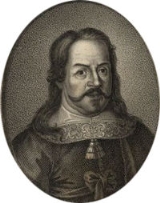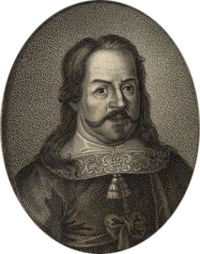
António Luís de Meneses
Encyclopedia

Marquis of Marialva
Count of Cantanhede was a Portuguese title of nobility created by a royal decree, dated from August 6, 1479, by King Afonso V of Portugal, and granted to D. Pedro de Menezes, 5th Lord of Cantanhede....
and 3rd Count of Cantanhede (December 13, 1603 – May 19, 1675) was a Portuguese general who fought in the Portuguese Restoration War
Portuguese Restoration War
Portuguese Restoration War was the name given by nineteenth-century 'romantic' historians to the war between Portugal and Spain that began with the Portuguese revolution of 1640 and ended with the Treaty of Lisbon . The revolution of 1640 ended the sixty-year period of dual monarchy in Portugal...
, that ended the Iberian Union
Iberian Union
The Iberian union was a political unit that governed all of the Iberian Peninsula south of the Pyrenees from 1580–1640, through a dynastic union between the monarchies of Portugal and Spain after the War of the Portuguese Succession...
between Portugal
Portugal
Portugal , officially the Portuguese Republic is a country situated in southwestern Europe on the Iberian Peninsula. Portugal is the westernmost country of Europe, and is bordered by the Atlantic Ocean to the West and South and by Spain to the North and East. The Atlantic archipelagos of the...
and Spain
Spain
Spain , officially the Kingdom of Spain languages]] under the European Charter for Regional or Minority Languages. In each of these, Spain's official name is as follows:;;;;;;), is a country and member state of the European Union located in southwestern Europe on the Iberian Peninsula...
.
Biography
Meneses was born in a noble family - his father was Dom Pedro de Menezes, 2nd count of Cantanhede, and his mother Dona Constança de Gusmão (daughter of Rui Gonçalves da Câmara, 1st count of Vila Franca ).Meneses was one of the key conspirators in the revolt against the Spanish Habsburgs on December 1, 1640. He took active part in the storming of the residence and the capture of the Duchess of Mantua, who governed Portugal in the name of Philip IV of Spain
Philip IV of Spain
Philip IV was King of Spain between 1621 and 1665, sovereign of the Spanish Netherlands, and King of Portugal until 1640...
(Philip III of Portugal). In 1641 he was assigned as general-commander (mestre-de-campo) of the Portuguese forces loyal to John IV of Portugal
John IV of Portugal
|-|John IV was the King of Portugal and the Algarves from 1640 to his death. He was the grandson of Catherine, Duchess of Braganza, who had in 1580 claimed the Portuguese crown and sparked the struggle for the throne of Portugal. John was nicknamed John the Restorer...
, and he organised the defences against Spanish attacks. He participated in almost every battle of the Portuguese Restoration War between 1641 and 1665. His greatest victories were the Battle of the Lines of Elvas
Battle of the Lines of Elvas
The Battle of the Lines of Elvas , was fought on 14 January 1659, in Elvas, between Portugal and Spain.-History:In 1658 a Spanish army commanded by D. Luis de Haro, was camped in the frontier of the Caia River, with 14,000 infantry, 3,500 cavalry and several pieces of artillery...
in 1659 and the Battle of Montes Claros
Battle of Montes Claros
The Battle of Montes Claros, was fought on June 17, 1665, near Vila Viçosa, between Spanish and Portuguese as the last battle in the Portuguese Restoration War....
in 1665. After the success in the first battle the Count of Cantanhede received among several honours, the title of Marquis of Marialva
Marquis of Marialva
Count of Cantanhede was a Portuguese title of nobility created by a royal decree, dated from August 6, 1479, by King Afonso V of Portugal, and granted to D. Pedro de Menezes, 5th Lord of Cantanhede....
on June 11, 1661. He was present at the signing of the Treaty of Lisbon on February 13, 1668.
His political career after the war was not as successful, and he died at Cantanhede, poor and forgotten, in 1675. He was buried in the Convent of Santo António in the same town.

